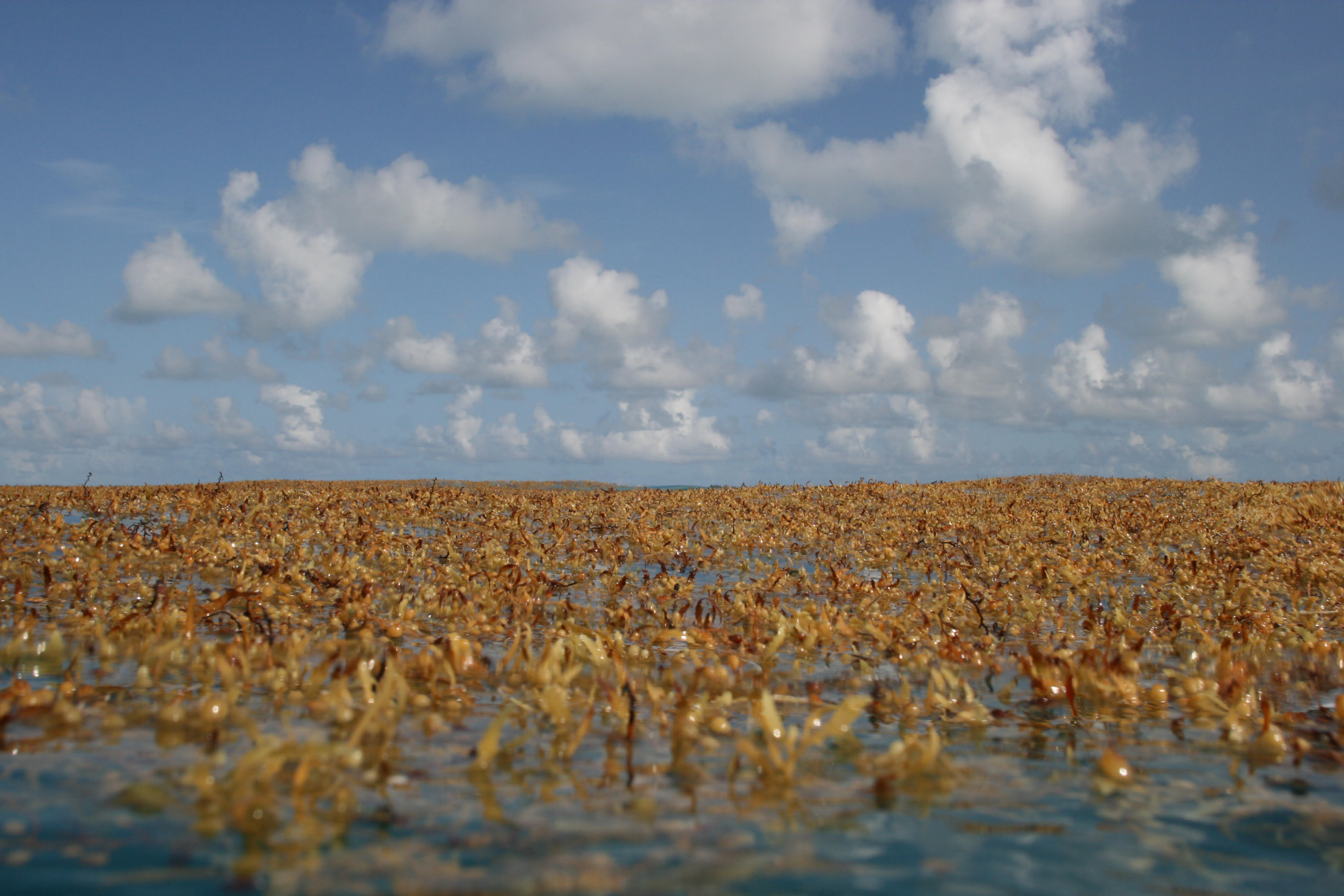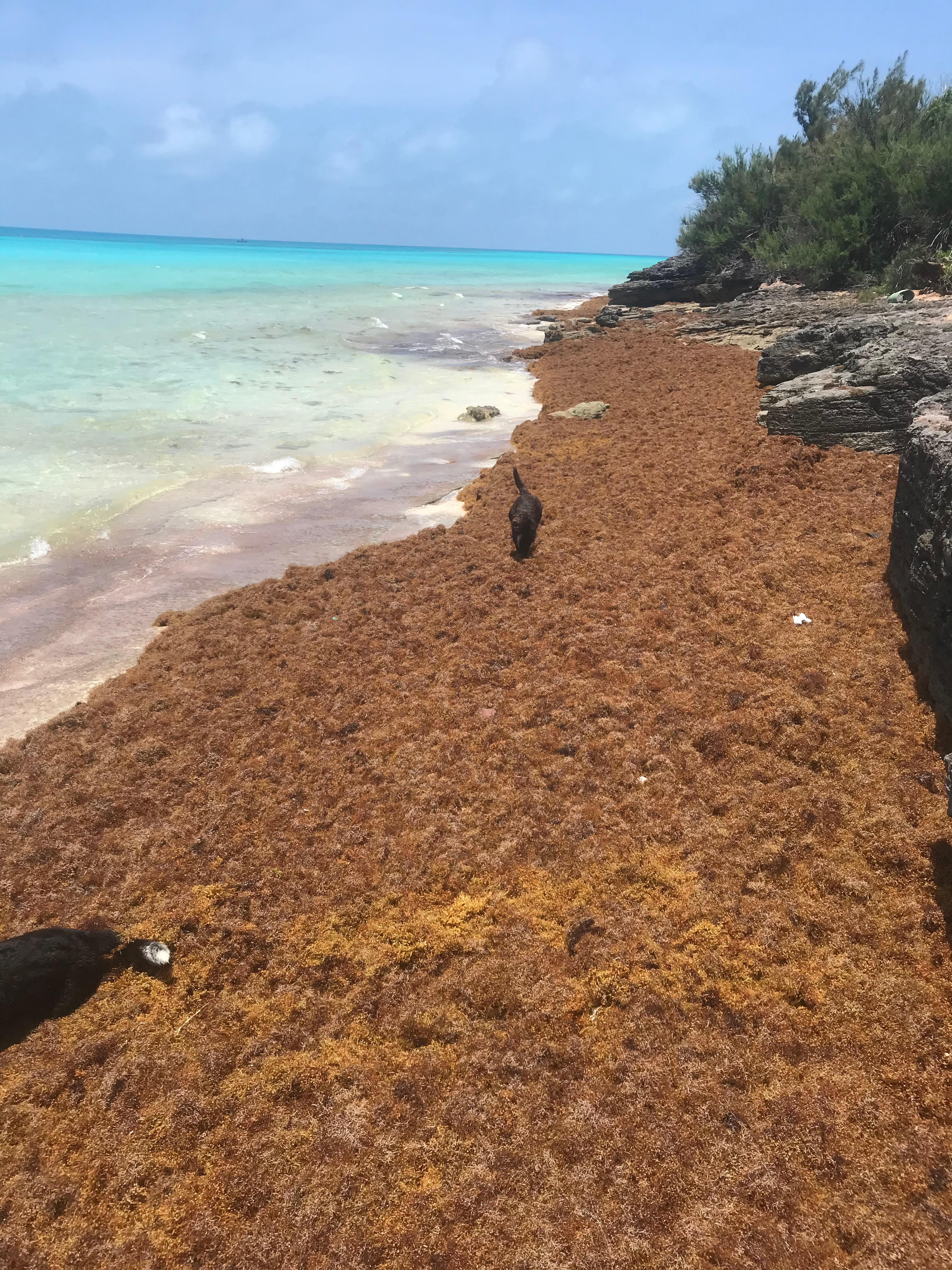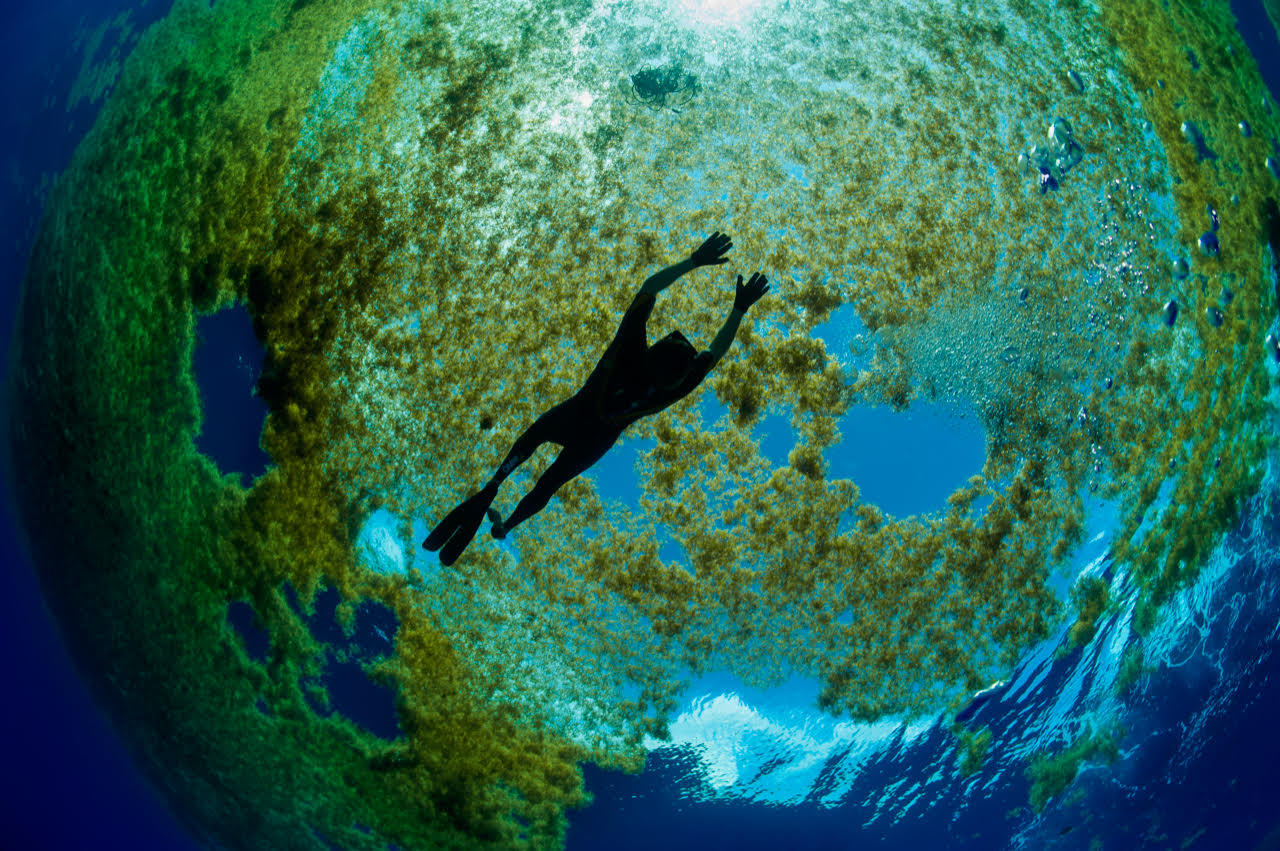New Hope Spot Champions of the Sargasso Sea to Conduct First Ecosystem Diagnostic Analysis of a High Seas System
March 11, 2022
Featured image: Philippe Rouja free diving under Sargassum in Challenger Banks, Bermuda (c) David Doubilet
SARGASSO SEA, NORTH ATLANTIC OCEAN (March 11th, 2022)
Often referred to as “the floating golden rainforest of the Atlantic Ocean”, the Sargasso Sea covers an impressive two million square miles of water. It has no land boundaries: rather, the area of the Sargasso Sea is defined by the whirling grasp of major currents within the North Atlantic Gyre. Vast mats of sun-soaked, free-floating yellow Sargassum seaweed bob at the surface under distinctively calm air.

The Sargasso Sea is a high seas ecosystem – it lies outside of the boundaries of any country. The high seas make up more than 60% of the ocean and while they possess deeply important biological diversity, they remain some of the least protected places on the planet. What is now the Sargasso Sea Commission began in 2009 as an initiative to protect the iconic North Atlantic ecosystem. This was a challenge, as the only way the Sargasso Sea could be protected was to push complex international agreements for ocean conservation, often not designed with high seas systems in mind, to their limits.
The Sargasso Sea was first named a Mission Blue Hope Spot in 2011, and is now recognized with the Commission as its Champion. The Hope Spot Champion’s next step is to conduct an Ecosystem Diagnostic Analysis utilizing two major grants to inform the development of a long-term conservation strategy.
Dr. Sylvia Earle, Founder of Mission Blue, says, “Thank you, Sargasso Sea Commission, for stepping up and committing to being a champion for the Sargasso Sea, the floating golden rainforest that is so important to so many creatures in the Atlantic Ocean.” She continues, “In 2009, I witnessed aboard the Galápagos expedition the efforts to bring people together to safeguard this important part of the ocean – an effort now realized as the Sargasso Sea Commission. It also marked the beginning of what has now become Mission Blue, and the concept of Hope Spots. So, thank you for embracing the Sargasso Sea as a Hope Spot.”

Wilfred Moore, Sargasso Sea Commissioner and Former Senator, says, “Protecting and conserving the Sargasso Sea and the species that live there has never been more important – it represents the critical intersection between the ocean and the economy.”
Rochelle Newbold, Sargasso Sea Commissioner and Special Advisor on Climate Change & Environmental Matters, Office of the Prime Minister, Nassau, the Bahamas, says, “The Sargasso Sea Hope Spot is like the Garden of Eden. It’s a unique, fragile part of the planet’s ocean system, and it is under threat.” Newbold believes that the upcoming Ecosystem Diagnostic Analysis of the Sargasso Sea will allow for more robust stewardship approaches for this high seas ecosystem than ever before.

On March 11, 2014, governments from several different countries met in Bermuda to sign the Hamilton Declaration on Collaboration for the Conservation of the Sargasso Sea (Hamilton Declaration), which established the Commission’s current structure. The Hamilton Declaration is the result of a negotiation between governments that are either located in the broader Sargasso Sea area or have an interest in high seas conservation. Today, ten governments have signed this declaration: the Azores, Bermuda, British Virgin Islands, the Bahamas, Canada, the Cayman Islands, the Dominican Republic, Monaco, the United Kingdom and the United States. While the Sargasso Sea Commission does not have a legally binding mandate, it works to promote international recognition of the importance of the Sargasso Sea, encourage scientific research to expand existing knowledge of the sea, and develop proposals for submission to existing organizations to promote the objectives of the Hamilton Declaration, supported by the endorsement of the Hamilton Declaration’s signatory governments.

In 2020, the Sargasso Sea Commission was awarded a 3-million-dollar grant from the Global Environment Facility (GEF) under the GEF programmatic approach entitled ‘Common Oceans’ – administered by the United Nations Food and Agricultural Organization. The Commission was also awarded a separate but complementary grant from the Fonds français pour l’environnement mondial (FFEM) focusing on the Sargasso Sea in the Atlantic and the Thermal Dome in the Pacific, entitled ‘Contributing to hybrid governance to protect and manage remarkable areas on the high seas: Tropical East Pacific and Northwest Atlantic Oceans’.

“These landmark grants will finance the first-ever Ecosystem Diagnostic Analysis (EDA) of a high seas system”, explains David Freestone, Executive Secretary of the Sargasso Sea Commission and Hope Spot Champion.
The EDA will build upon the original science case that saw the Sargasso Sea described as an EBSA by the CBD in 2012. This EDA will form the technical basis for a stakeholder-endorsed Strategic Action Programme (SAP) for future stewardship of the Sargasso Sea – which should allow for conservation strategies to be implemented for the Sargasso Sea that have not been possible to date.
Andrew Hudson, Head, Water & Ocean Governance Programme at UNDP, explains, “this analysis will provide an ongoing basis for monitoring and subsequent stewardship and management responses, and could provide useful detail for replicating the Commission’s ecosystem stewardship structure in other ecosystems in Areas Beyond National Jurisdiction (ABNJ).”

The objective of the GEF project is to facilitate a collaborative and cross-sectoral stewardship mechanism for the Sargasso Sea through improvement in the knowledge base and strengthened frameworks for collaborative management and governance. This is the first-ever GEF grant designed to address conservation and governance in a well-defined high seas ecosystem. The United Nations Development Programme is the Implementing agency for the project, and the Intergovernmental Oceanographic Commission of UNESCO is the executing agency. Other partners of the project include the Bermuda Institute of Ocean Sciences, Duke University Marine Spatial Ecology Lab, the Imperial College London Centre for Environmental Policy, The University of Edinburgh, and the World Maritime University.

The FFEM grant is split between the Sargasso Sea Commission and MarViva, an NGO working to protect the Thermal Dome in Costa Rica, and aims to develop appropriate governance frameworks, which will help future conservation of other high seas areas.
Freestone touches on what these next steps could mean for the future of ocean conservation. “The Sargasso Sea provides hope for the future in the sheer wonder associated with the species it supports”, he says. “Comprehensive protection of the Sargasso Sea, in particular, would offer hope for the future of high seas conservation, in which similar mechanisms could be developed across other invaluable ecosystems around the world.”

About the Sargasso Sea Commission
The Commission’s role is to act as the Steward of this iconic high seas ecosystem and to keep its health, productivity, and resilience under review, as well as to develop safeguard measures for its conservation. It is a unique institution as Commissioners are appointed primarily according to their scientific and technical expertise, and serve in their personal capacity rather than being representatives of the Signatory Governments.
The Commissioners currently serving are Dr. Tammy Warren (Acting Chairperson), Prof. Howard Roe, Mrs. Rochelle Newbold, Prof. Stephen de Mora, Sen. Wilfred Moore, Mr. Mark Spalding, and Dr. Ana Colaço. More information about the technical backgrounds of each Commissioner can be found on the Sargasso Sea Commission website.








